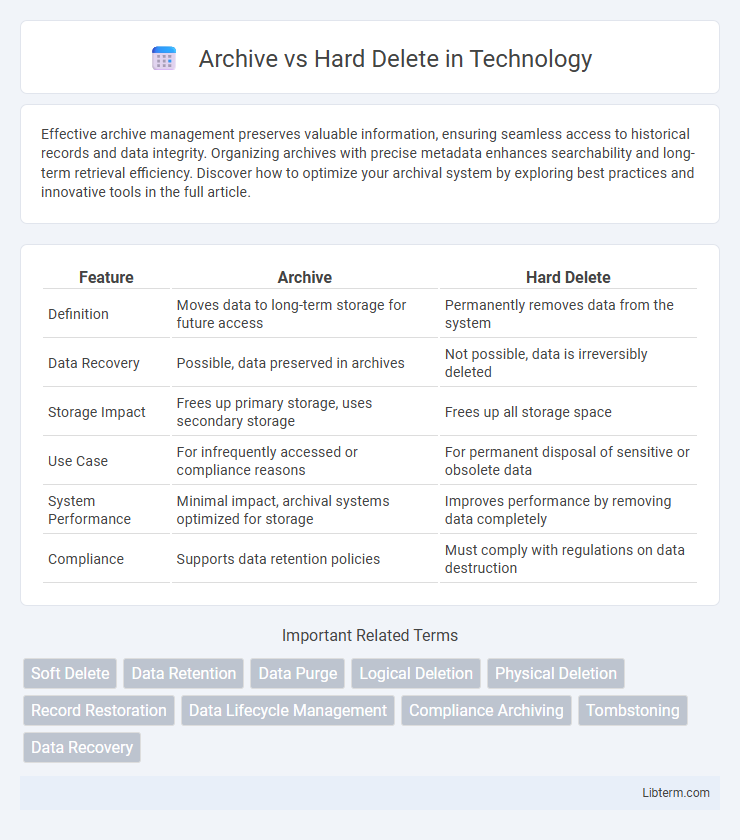Effective archive management preserves valuable information, ensuring seamless access to historical records and data integrity. Organizing archives with precise metadata enhances searchability and long-term retrieval efficiency. Discover how to optimize your archival system by exploring best practices and innovative tools in the full article.
Table of Comparison
| Feature | Archive | Hard Delete |
|---|---|---|
| Definition | Moves data to long-term storage for future access | Permanently removes data from the system |
| Data Recovery | Possible, data preserved in archives | Not possible, data is irreversibly deleted |
| Storage Impact | Frees up primary storage, uses secondary storage | Frees up all storage space |
| Use Case | For infrequently accessed or compliance reasons | For permanent disposal of sensitive or obsolete data |
| System Performance | Minimal impact, archival systems optimized for storage | Improves performance by removing data completely |
| Compliance | Supports data retention policies | Must comply with regulations on data destruction |
Understanding Archive and Hard Delete
Archive involves moving data to a separate storage for long-term retention, preserving it for future access and compliance, while minimizing impact on active systems. Hard Delete permanently removes data from the database or storage, ensuring it cannot be recovered, which is essential for maintaining data privacy and regulatory requirements. Choosing between archive and hard delete depends on legal obligations, data recovery needs, and system performance considerations.
Key Differences Between Archiving and Hard Deleting
Archiving preserves data by moving it to a separate storage location for long-term retention and future retrieval, while hard deleting permanently removes data without recovery options. Archived data remains accessible for compliance, auditing, or reference purposes, whereas hard-deleted data is irretrievably erased to free up storage and ensure privacy. The key difference lies in data recoverability and intended lifespan, with archiving supporting data preservation and hard deleting focusing on data elimination.
Use Cases for Archiving Data
Archiving data is ideal for preserving historical records, compliance with regulatory requirements, and long-term storage without impacting system performance. Use cases include financial records retention, audit trails, and customer data for future analysis or legal purposes. Archiving enables cost-effective, secure storage while maintaining data accessibility when needed.
When to Choose Hard Delete
Choose hard delete when data retention poses a security risk or violates compliance regulations, ensuring sensitive information is permanently removed from all storage locations. Hard delete is appropriate for obsolete or redundant data that no longer holds business value, preventing unnecessary storage costs and maintaining system performance. Opt for hard delete in scenarios requiring immediate data erasure, such as legal mandates or data breach remediation, to eliminate any possibility of recovery or unauthorized access.
Impact on Data Recovery
Archiving data preserves it in a separate storage, enabling easy retrieval and restoring without loss, which is critical for compliance and long-term access. Hard delete permanently removes data from the system, making recovery impossible through standard means and potentially causing irreversible data loss. Understanding the distinction between archive and hard delete impacts backup strategies, disaster recovery plans, and regulatory adherence.
Security Implications of Each Method
Archiving data preserves information in a secure, encrypted format that allows for controlled access and audit trails, minimizing the risk of unauthorized exposure. Hard deletion completely removes data from storage, reducing the attack surface but posing challenges for compliance and recovery if data is deleted prematurely or maliciously. Organizations must weigh the security benefits of reducing residual data with hard delete against the compliance and forensic value of archived data storage.
Storage Management Considerations
Archive stores data in a less accessible format to free up primary storage while retaining information for future use, optimizing storage costs and compliance needs. Hard delete permanently removes data from the storage system, freeing all associated storage space immediately but eliminating recovery options. Choosing between archive and hard delete depends on balancing long-term storage requirements, regulatory compliance, and effective disk space management.
Regulatory and Compliance Issues
Archive solutions retain data in a secure, tamper-evident environment meeting regulatory mandates such as GDPR, HIPAA, and SOX, ensuring compliance with data retention and audit requirements. Hard delete permanently removes data, potentially conflicting with legal obligations to preserve records for specified periods, risking non-compliance and penalties. Organizations must balance data deletion practices against industry-specific regulations and corporate governance policies to avoid breaches and legal consequences.
Performance Effects on Systems
Archiving data preserves information by moving it to slower, less expensive storage, reducing primary system load and improving query speed. Hard deleting eliminates data permanently, freeing up storage and enhancing write performance but risks data loss if deletion is premature. Systems with heavy read operations benefit from archiving, while those prioritizing storage efficiency and write speed favor hard deletes.
Choosing the Right Strategy for Your Needs
Choosing between archive and hard delete depends on data retention policies and business requirements. Archiving preserves data for future access and compliance, reducing storage impact without permanent loss, while hard delete completely removes data, enhancing security but risking data loss. Evaluate factors such as regulatory obligations, data retrieval frequency, and storage costs to determine the optimal strategy for efficient data management.
Archive Infographic

 libterm.com
libterm.com